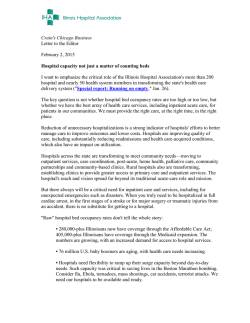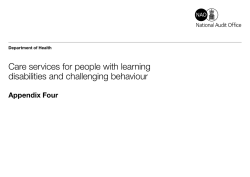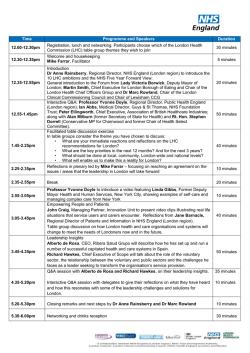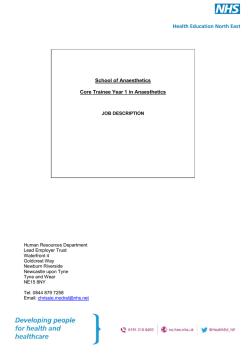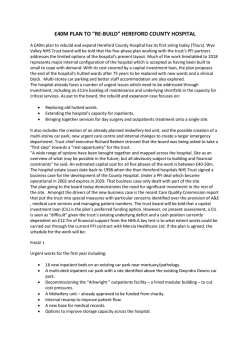
executive summary - National Audit Office
Report by the Comptroller and Auditor General Department of Health Care services for people with learning disabilities and challenging behaviour HC 1028 SESSION 2014-15 4 FEBRUARY 2015 4 Key facts Care services for people with learning disabilities and challenging behaviour Key facts 2,600 £557m 13 inpatients with learning disabilities in mental health hospitals at September 2014 NHS spending on inpatients with learning disabilities in mental health hospitals, 2012-13 Winterbourne View commitments met, out of the 20 key commitments government set itself £5.3 billion spent by local authorities on community services for adults with learning disabilities, in 2013-14 1 June 2014 date in the Winterbourne View Concordat when all people, for whom it was appropriate, should have transferred from mental health hospitals into the community 920 people in mental health hospitals who still had no date for planned transfer to the community, at September 2014 (for 691 of these, a clinician had decided that they were not ready) 150 unannounced Care Quality Commission inspections after the Winterbourne View scandal: 71 NHS trusts, 47 private services and 32 care homes 83% of the 2,600 people in mental health hospitals were sectioned under the Mental Health Act, as of September 2014 6 years and 9 months average length of continuous inpatient stay (including transfers between hospitals) in the 4 hospitals we visited 17 years and 4 months average length of stay, including admissions and readmissions, in the 4 hospitals we visited 50+ kilometre journey from hospital to home for 36.5% of inpatients in mental health hospitals Care services for people with learning disabilities and challenging behaviour Summary 5 Summary 1 In May 2011, a BBC Panorama programme exposed staff abuse of patients with learning disabilities at Winterbourne View, a private mental health hospital. The government responded with a commitment to transform services for all people with learning disabilities or autism who had challenging behaviour or a mental health condition. The Department of Health (the Department) led the government’s review. 2 In December 2012, the Department published Transforming care: A national response to Winterbourne View Hospital and the accompanying DH Winterbourne View Review – Concordat: Programme of Action (the Concordat). The Concordat set out the government’s pledge to work with others to meet the 63 Transforming care commitments (the commitments). There was one central commitment. By 1 June 2014, if anyone with a learning disability and challenging behaviour would be better off supported in the community, then they should be moved out of hospital. As a consequence, the government expected to see a dramatic reduction in hospital placements and large mental health hospitals closed, so a new generation of inpatients did not take the place of people then in hospital. 3 The challenge of discharging people with learning disabilities and challenging behaviour dates back, at least, to the care in the community programme and associated hospital closure programme in the 1980s. It is a classic ‘wicked issue’ – that which defies simple solutions. As Figure 1 overleaf shows, it involves complex interrelated events, processes and services for admitting, and assessing, treating and discharging patients. All of which must work together for the system to work as intended. 4 The Department sets the strategy to improve quality and safety, enable change and measure and monitor progress. A cross-government Learning Disability Programme Board oversees the programme of transforming care services. The Department aimed to assure that the 51 organisations signed up to the Concordat’s vision worked together to achieve the shared objectives. However, in line with the Health and Social Care Act 2012, NHS England, mental health hospitals, and local health and social care commissioners determined how to meet those commitments. 5 We estimate that the NHS spent £557 million on services for inpatients with learning disabilities and challenging behaviour in 2012-13. In addition, local authorities with adult social services responsibilities spent £5.3 billion (2013-14) on services for adults with learning disabilities. 6 Summary Care services for people with learning disabilities and challenging behaviour Figure 1 Progress from hospital admission to discharge Integrated Care Programme Approach Organisations and professionals Patient advocate Mental health professional Local area Return to family Nursing specialists Sectioned under the Mental Health Act Care coordinator Independent living Clinical commissioning group Mental health Tribunal Community specialists CQC Medical referral Patient admission to hospital Local care providers Care home provider Assessment – Treatment – Discharge planning Discharge Activities and services Voluntary admission Community placement Consultation Identify risks Clinical decision on discharge Budgeting for care Transfer from prison Return to prison Clinical diagnosis Transfer between hospitals Care plan Design community placement Patient reviews Safeguarding Register Risk management Quality inspections Commissioning local providers Securing resources Readmission to hospital from community placements Note 1 ‘Clinical commissioning group register’ was called the ‘primary care trust register’ in the Concordat. Source: National Audit Office Transfer between hospitals Care services for people with learning disabilities and challenging behaviour Summary 7 Scope of this report 6 We have focused on the cohort of inpatients with a learning disability and challenging behaviour in mental health hospitals in England. A learning disability is a reduced intellectual ability and difficulty with everyday activities. A minority of people with learning disabilities exhibit challenging behaviour and can present a risk to themselves and to others. The report examines: • the challenge the government faced, in meeting its commitments (Part One); • performance against the commitments (Part Two); and • barriers to transforming care services (Part Three). 7 Our methods are set out in Appendices One and Two. Key findings Understanding the scale of the challenge 8 In December 2012, when agreeing the Concordat, the scope and the quality of data on patients with learning disabilities was poor. Without an accurate picture of the scale of the task, remedial action may be misdirected, or not match the scale of the challenge. Early estimates of the size of the inpatient population were inaccurate and incomplete. The Health and Social Care Information Centre’s census of mental health hospitals (September 2013) and NHS England’s second census of commissioners (March 2014) eventually gave reasonable estimates of the inpatient population. They respectively estimated that there were 3,250 and 2,615 inpatients. The Department has asked the Health and Social Care Information Centre to develop the Mental Health and Learning Disabilities Data Set, to give sustained good-quality data (paragraphs 2.2 and 2.23). 9 Only 73 of the 3,250 people in the 2013 census had been clinically assessed as posing such a risk to themselves, or others, that they needed to be in a high security hospital. The government assumed there would be a dramatic reduction in hospital placements, large hospitals would close and there would be few new inpatients. Along with the expectations in the 2012 Concordat, families, carers and local stakeholders expected that almost all the 3,250 people in hospital would be discharged into more appropriate community settings, by 1 June 2014. However, 1,042 people were subject to restrictions under Part III of the Mental Health Act and related legislation. This may suggest a continued need for good-quality inpatient provision near where people live (paragraph 2.3). 8 Summary Care services for people with learning disabilities and challenging behaviour 10 The government underestimated the complexity and level of challenge involved in meeting its commitments. When it published the Concordat, the government did not know the size of the challenge to increase the capacity of community placements. It had little information on whether local commissioners could put in place the bespoke community placements and personalised care plans required to manage risks and prevent readmissions. The government had not analysed why new patients were referred to hospitals (including the impact on the total inpatient population). It has not quantified the resources needed to accelerate patients’ readiness for discharge, to meet the 1 June 2014 target date (paragraph 2.4). Putting in place effective delivery mechanisms 11 The government left it to mental health hospitals, NHS commissioners, and local authorities to decide how to meet the commitments. In line with the provisions of the Health and Social Care Act 2012, the Department did not have the traditional levers to implement the necessary changes, such as national monitoring, mandatory guidance, additional funding to build capacity, pooled budgets or dedicated funding. In addition, local authorities, primary care trusts (now clinical commissioning groups) and hospitals – those responsible for meeting the commitments – were not asked to sign up to the Concordat. The Department did, however, mandate NHS England to take forward key commitments and invested £5 million in the Transforming care programme, designed to support health and care commissioners (paragraphs 1.13, 1.15 and 2.15). 12 As funding did not follow the patient, there was no financial incentive for local areas to bring patients home. Around half of inpatients are funded directly by NHS England. There can be substantial extra costs to local health and care commissioners to meet discharged patients’ community care needs when their hospital care was previously funded by NHS England. This was not a hospital closure programme. However, previous commitments to discharge large numbers of inpatients had associated funding to build and maintain community services. However, there was neither funding for patient transfers, nor pump-priming money, available for this programme (paragraphs 2.15, 2.24, 2.25 and 3.1). Care services for people with learning disabilities and challenging behaviour Summary 9 Performance against key Concordat commitments 13 NHS England has regularly reviewed the status for the 48 patients who had been at Winterbourne View when it closed. The latest review, between January and June 2014, showed that (paragraph 2.14): • 10 people were still in hospital; • 20 were in residential care; • 5 were in supported housing with their own tenancies; • 12 had their own general needs tenancy; and • one had died. 14 Despite progress on most main commitments, the government did not dramatically reduce hospital placements or new admissions. Out of 20 key commitments that the government set, 6 were met by the target date, 7 were met but not by the target date, and 7 have not yet been met. Most progress has been made on commitments to publish guidance, best practice and standards. Data at June 2014, the date for meeting the key Concordat commitment, shows the following (paragraphs 2.6 to 2.9, Figures 3 and 4): • The number of people with learning disabilities and challenging behaviour in hospital was broadly stable at 2,615 in March 2014 and 2,601 in June 2014. • Over the three quarters ending December 2013 to June 2014, there were 902 hospital admissions compared with 600 discharges, a net gain of 302. However, this data does not distinguish between discharges to community settings, or transfers to other hospitals. • At June 2014, 2,024 of the 2,601 inpatients had no planned transfer or discharge date and 1,614 of these had received a clinical decision not to transfer. This was despite an NHS England requirement that commissioners should ensure that when someone is admitted to hospital they have a planned transfer or discharge date. • At June 2014, for 1,296 of the 2,601 inpatients, their local authority did not know they might transfer to their area on discharge from hospital. • In addition, the September 2013 census of hospitals showed that 36.5% of inpatients were in hospitals over 50 kilometres from their home area. 10 Summary Care services for people with learning disabilities and challenging behaviour 15 The Health and Social Care Information Centre did not give the information we needed, to validate the quality of their annual inpatient census data. Consequently, we primarily analysed NHS England’s quarterly census data, which we validated (Appendix Two paragraph 10). 16 The Care Quality Commission made unannounced inspections at 150 services after the Winterbourne View scandal. The Commission was responsible for inspecting, regulating and ensuring that services met the agreed model of care. It focused on two standards: care and welfare; and, protecting health and well-being and enabling inpatients to live free from harm. Excluding 5 pilot inspections, the Commission found 69 failed to meet one or both standards, some hospitals admitted people for long periods, and discharges took too long to arrange (paragraph 2.13). 17 NHS England lacks adequate and reliable data to monitor progress. In 70% of the 281 case files we reviewed at visits to 4 hospitals, there was at least one error in the June 2014 quarterly census data submitted to NHS England. Official data for our cohort of 281 patients showed an average stay of 3 years and 10 months. The actual length of stay was 4 years and 3 months in their current hospital. The census reports only the length of stay in any given hospital ward. It does not include total continuous inpatient stay – in the same or another hospital. Also, the data does not show how many times a patient is admitted to hospital or the total time they spent there. NHS England needs both to effectively understand and manage discharges and to stem the flow of people into hospital. Our cohort of 281 cases had a total average length of continuous inpatient stay (including transfers between hospitals) of 6 years and 9 months. For admissions and readmissions, the average total inpatient stay was 17 years and 4 months, although this was not a statistically significant sample (paragraphs 2.20, 2.21 and Figure 7). Response to missing key commitments 18 The Department and NHS England have acknowledged the slow progress in meeting the key Concordat commitments. In April 2014, NHS England identified the need for plans to ensure that people have effective care and treatment reviews and set a level of ambition for discharges which the NHS, working with local partners, could deliver. The Department asked NHS England, in May 2014, to put together an action plan and publish it by the end of August. The plan was presented to the Transforming Care Assurance Board in September 2014. NHS England commissioned Sir Stephen Bubb to review how best to increase local community care provision and move people with learning disabilities out of hospital. He concluded that “we make it too hard for stakeholders across the system to make change happen, and too easy to continue with the status quo” (paragraphs 2.26 to 2.28). Care services for people with learning disabilities and challenging behaviour Summary 11 19 NHS England set a new ambition in August 2014 to transfer 50% (around 1,300) of people who were inpatients on 1 April 2014 to more appropriate care settings by 31 March 2015. In November 2014, NHS England clarified that it meant discharges from mental health hospitals and not transfers between them. NHS England said that around 400 of this cohort of inpatients had been discharged in the first 7 months of 2014-15. The ambition requires a further 900 to be discharged in the remaining 5. However, the figures do not separately identify transfers to other hospitals or readmissions, so overstate progress to an unknown degree. When we met with local authorities, clinical commissioning groups and hospitals (those to be tasked with delivery) in October 2014, they were unaware of NHS England’s ambition. However, although there was no central implementation plan, risk assessment or mitigation plans, NHS England told us that during our work (paragraphs 2.29 to 2.31): • each of its regional directors was accountable for progress with the new ambition; • the national learning disability programme team developed protocols for care and treatment reviews to identify patients with no clinical need for inpatient care; and • it has worked with the Local Government Association and the Association of Directors of Adult Social Services to address gaps in communication to clinical commissioning groups and local authorities. 20 There is no timetable or ambition to reduce the inflow of inpatients with learning disabilities or close hospitals. The 2012 Concordat stated that the commitments would mean a new generation of inpatients did not take the place of people then in hospital. The mental health hospitals we visited all had waiting lists for admission. So simply discharging existing patients would not reduce their overall numbers, if these patients were all replaced by new admissions. Some people will, however, continue to need high-quality local inpatient services because of a crisis in their community care or serious offending behaviour (paragraphs 1.13, 2.8 to 2.10). Building sustainable community based care services 21 Joint work between health and social care commissioners is vital to make discharges from mental health hospitals sustainable. Discharges are more likely to succeed where local multidisciplinary teams work closely with hospital clinicians and hospital outreach teams to design and commission bespoke care plans and intervene quickly to prevent readmissions. We found cases of significant delays in decision-making on funding for bespoke community based care packages. Mental health hospitals have the advantage of economies of expertise for treating mental ill health, such as personality disorder. And they understand best how to apply psychiatric, psychological, linguistic and occupational therapeutic treatments, specifically built around the needs of people with a learning disability. This is an underused resource and should be available locally (paragraphs 2.24 and 3.5). 12 Summary Care services for people with learning disabilities and challenging behaviour 22 Developing robust community services for people with a learning disability and challenging behaviour takes time. Salford local authority and clinical commissioning group (previously the primary care trust) is often identified as a beacon of good practice. It has a joined up health and social care management and commissioning structure with a pooled budget. This supports a co-located and multidisciplinary team, committed to keeping people out of mental health hospitals by supporting them in the community. However, this single service has taken over a decade to introduce (paragraph 3.10). Conclusion 23 Moving people with learning disabilities and challenging behaviour out of hospital, where appropriate, is a complex process which defies short-term solutions. Unless all parts of the health and social care systems work effectively together, it is unlikely to happen. Despite government efforts, and the key commitments it has met, it did not achieve this central goal by the target date. This was partly because there are no mechanisms for systematically pooling resources to build sufficient capacity in the community for this to happen. 24 The government faces 3 challenges in improving the care for people with learning disabilities and challenging behaviour. First, to determine the most appropriate place for people’s assessment and treatment. Second, to reduce the number of people with learning disabilities in inappropriate settings. And third, to create a sustainable system that minimises the need for inpatient care settings. While NHS England has made a disappointingly slow start to this task, there are signs of progress in documenting people’s readiness for discharge, if not yet in reducing admissions. The nature and pace of joint-working between health and social care commissioners must change if they are to meet their commitments. Care services for people with learning disabilities and challenging behaviour Summary 13 Recommendations 25 Our recommendations are interdependent, and would be unlikely to maximise performance against the government’s commitments if taken only in isolation. 26 The government must improve data, ensure there are discharge plans for inpatients, and introduce a readmissions performance indicator: a improve data quality and coverage, by including the numbers and flows of patients through the health, social care and criminal justice systems (using the Mental Health and Learning Disability Data set); b through NHS England, ensure that every inpatient, who does not pose such a risk that they need to be in a high-security hospital, has a discharge plan by 31 January 2016; and c through the Mental Health and Learning Disability Data set, introduce a readmissions performance indicator to assess how sustainable care packages for discharged patients are. 27 The government should use the mechanisms offered by the Better Care Fund to mandate pooled budgets for care services for people with learning disabilities from April 2016. Local areas should work with NHS England and pool budgets to make joint decisions on care, which would incentivise the joining up of health and social care services. This should be underpinned by: a funds that follow the person with learning disabilities from hospital to the community; b co-locate multidisciplinary teams of learning disability specialists to plan and support discharges and train providers; and c having a named coordinator for each inpatient who attends every biannual review meeting, primarily focusing on planning their discharge. 28 Clinical commissioning groups, local authorities and NHS England should better use the economies of expertise within mental health hospitals in the ongoing care of people discharged from hospital. This should include designing discharge and care plans. This would help prevent the mental ill health of people with learning disabilities and challenging behaviour deteriorating to the point that they become a risk to the public, or themselves, and require readmission.
© Copyright 2025
